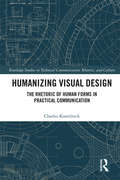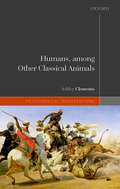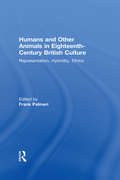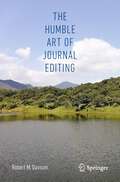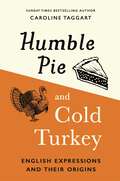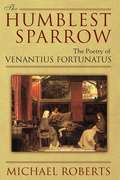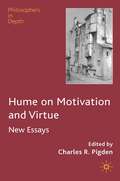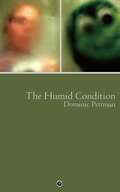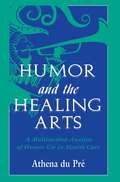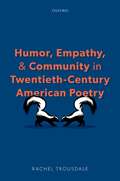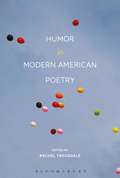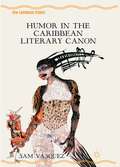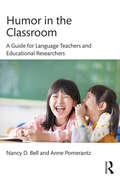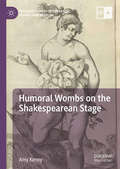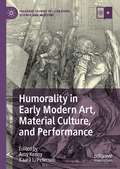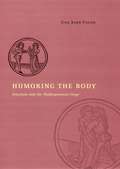- Table View
- List View
Humanizing Visual Design: The Rhetoric of Human Forms in Practical Communication (Routledge Studies in Technical Communication, Rhetoric, and Culture)
by Charles KostelnickThis book analyzes the role that human forms play in visualizing practical information and in making that information understandable, accessible, inviting, and meaningful to readers—in short, "humanizing" it.Although human figures have long been deployed in practical communication, their uses in this context have received little systematic analysis. Drawing on rhetorical theory, art history, design studies, and historical and contemporary examples, the book explores the many rhetorical purposes that human forms play in functional pictures, including empowering readers, narrating processes, invoking social and cultural identities, fostering pathos appeals, and visualizing data.The book is aimed at scholars, teachers, and practitioners in business, technical, and professional communication as well as an interdisciplinary audience in rhetoric, art and design, journalism, engineering, marketing, science, and history.
Humans, among Other Classical Animals (Postclassical Interventions)
by Ashley ClementsWe are living in a moment of environmental and existential crisis that demands a response. Why then study Classics now? From the European assimilation and destruction of the New World to our present environmental destruction of our shared world, Humans, among Other Classical Animals explores in encounters an answer by demonstrating how the Classics have been implicated in the structures of thought that have ultimately led us to our present historical moment. Telling the story of anthropology's Classical entanglements from its inception to its growth to critical self-awareness, it demonstrates that Classical ideas have played a crucial -and often deleterious- role in the Western placing of the human and in the discipline that claimed the study of humanity as its own. Responses to our present crisis, it argues, should therefore include as a prerequisite, considering the origins and implications of these Classical foundations because only by so doing can we attain the full self-awareness necessary to think beyond them and consider the alternatives we now need. Postclassical Interventions aims to reorient the meaning of antiquity across and beyond the humanities. Building on the success of Classical Presences, this complementary series features shorter-length monographs designed to provoke debate about the current and future potential of Classical Reception through fresh, bold, and critical thinking.
Humans, among Other Classical Animals (Postclassical Interventions)
by Ashley ClementsWe are living in a moment of environmental and existential crisis that demands a response. Why then study Classics now? From the European assimilation and destruction of the New World to our present environmental destruction of our shared world, Humans, among Other Classical Animals explores in encounters an answer by demonstrating how the Classics have been implicated in the structures of thought that have ultimately led us to our present historical moment. Telling the story of anthropology's Classical entanglements from its inception to its growth to critical self-awareness, it demonstrates that Classical ideas have played a crucial -and often deleterious- role in the Western placing of the human and in the discipline that claimed the study of humanity as its own. Responses to our present crisis, it argues, should therefore include as a prerequisite, considering the origins and implications of these Classical foundations because only by so doing can we attain the full self-awareness necessary to think beyond them and consider the alternatives we now need. Postclassical Interventions aims to reorient the meaning of antiquity across and beyond the humanities. Building on the success of Classical Presences, this complementary series features shorter-length monographs designed to provoke debate about the current and future potential of Classical Reception through fresh, bold, and critical thinking.
Humans and Other Animals in Eighteenth-Century British Culture: Representation, Hybridity, Ethics
by Frank PalmeriCombining historical and interpretive work, this collection examines changing perceptions of and relations between human and nonhuman animals in Britain over the long eighteenth century. Persistent questions concern modes of representing animals and animal-human hybrids, as well as the ethical issues raised by the human uses of other animals. From the animal men of Thomas Rowlandson to the part animal-part human creature of Victor Frankenstein, hybridity serves less as a metaphor than as a metonym for the intersections of humans and other animals. The contributors address such recurring questions as the implications of the Enlightenment project of naming and classifying animals, the equating of non-European races and nonhuman animals in early ethnographic texts, and the desire to distinguish the purely human from the entirely nonhuman animal. Gulliver's Travels and works by Mary and Percy Shelley emerge as key texts for this study. The volume will be of interest to scholars and students who work in animal, colonial, gender, and cultural studies; and will appeal to general readers concerned with the representation of animals and their treatment by humans.
Humans and Other Animals in Eighteenth-Century British Culture: Representation, Hybridity, Ethics
by Frank PalmeriCombining historical and interpretive work, this collection examines changing perceptions of and relations between human and nonhuman animals in Britain over the long eighteenth century. Persistent questions concern modes of representing animals and animal-human hybrids, as well as the ethical issues raised by the human uses of other animals. From the animal men of Thomas Rowlandson to the part animal-part human creature of Victor Frankenstein, hybridity serves less as a metaphor than as a metonym for the intersections of humans and other animals. The contributors address such recurring questions as the implications of the Enlightenment project of naming and classifying animals, the equating of non-European races and nonhuman animals in early ethnographic texts, and the desire to distinguish the purely human from the entirely nonhuman animal. Gulliver's Travels and works by Mary and Percy Shelley emerge as key texts for this study. The volume will be of interest to scholars and students who work in animal, colonial, gender, and cultural studies; and will appeal to general readers concerned with the representation of animals and their treatment by humans.
The Humble Art of Journal Editing
by Robert M. DavisonThe publication of scholarly research is both a major driver of social progress and a significant industry in its own right. Scholarly research is the focus of attention for countless numbers of scholars globally and a key measure of scholarly excellence. Much has been written about the conduct of research that is designed to help scholars attain appropriate standards of rigor and relevance, and indeed craft their research outputs in ways appropriate for different venues, notably as journal articles, conference papers, book chapters, and books. However, although scholarly researchers fulfill roles other than as authors, for instance as journal reviewers and editors, there is a dearth of consolidated information about the nature of editorial work. Drawing on over two decades of experience in editing scholarly journals, the author offers a more systematic guide to scholarly journal editing.The book begins with an introduction to the art of scholarly journal editing,the nature of that art (Chapter 1), and an examination of editorial promulgation of cultural values of scholarly journals with an emphasis on responsible research (Chapter 2). Chapter 3 examines the many issues associated with sourcing content, and opines on the novelty, breadth, and depth of research, including discussions of indigenous theorization, serendipity, iconoclastic research, and the value of special issues. Chapter 4 deals with the review process and offers advice for formulating effective reviewer guidelines that lead to constructive and developmental advice for authors. The next two chapters discuss the audience of the journal as well as publisher relations. Finally, the book is concluded with thoughts and recommendations about emerging challenges, such as the ethics of AI tools (like ChatGPT), predatory journals, and the open-access movement.Offering a practical guide to editing scholarly journals, this book will be a key resource for scholars making the leap from researcher to editor, regardless of discipline.
Humble Pie and Cold Turkey: English Expressions and Their Origins
by Caroline Taggart‘Caroline Taggart has carved out a niche for herself in user-friendly, wittily written factual books.’ – Yorkshire Post______________________In this highly entertaining book, language enthusiast and Sunday Times best-selling author Caroline Taggart browses through thousands of years of history to shed light on why we use the words and phrases we do. Arranged by themes including food, the household, childhood, romance and more, this intriguing book looks at the origins of our language from their historical context. For example, did you know that: If you rest on your laurels, you’re imitating a complacent Roman general? If you eavesdrop, you’re likely to get wet? If you’re taken aback, you should, strictly speaking, be a sailing ship? If you’re galvanized into action, you’re behaving like Frankenstein’s monster?From blue-blooded (an invention of aristocratic Spaniards) to limelight (a way of lighting Victorian theatres), passing an exam with flying colours (another image from sailing ships) to winning hands down (from horse racing), Humble Pie and Cold Turkey will answer questions you may never have thought to ask. Including why turkeys need to be cold and how pies came to be humble.
The Humblest Sparrow: The Poetry of Venantius Fortunatus
by Michael RobertsIn The Humblest Sparrow, Michael Roberts illuminates the poetry of the sixth-century bishop and poet Venantius Fortunatus. Often regarded as an important transitional figure, Fortunatus wrote poetry that is seen to bridge the late classical and earlier medieval periods. Written in Latin, his poems combined the influences of classical Latin poets with a medieval tone, giving him a special place in literary history. Yet while interest has been growing in the early Merovingian period, and while the writing of Fortunatus' patron Gregory of Tours has been well studied, Fortunatus himself has often been neglected. This neglect is remedied by this in-depth study, which will appeal to scholars of late antique, early Christian, and medieval Latin poetry. Roberts divides Fortunatus' poetry into three main groups: poetry of praise, hagiographical poetry, and personal poetry. In addition to providing a general survey, Roberts discusses in detail many individual poems and proposes a number of theses on the nature, function, relation to social and linguistic context, and survival of Fortunatus' poetry, as well as the image of the poet created by his work. Jacket illustration: L. Alma Tadema, Venantius Fortunatus Reading his Poems to Radegonda VI AD 555. (Courtesy of Dordrecht, Dordrechts Museum.)
Hume on Motivation and Virtue (Philosophers in Depth)
by C. PigdenThis collection is devoted to questions in meta-ethics and moral psychology arising from the work of David Hume. The collection focuses on questions arising from Hume's views on reason, motivation and virtue including new essays from notable Hume scholars.
The Humid Condition: (More) Overheated Observations
by Dominic PettmanThe Humid Condition: (More) Overheated Observations continues on the clicking heels of Dominic Pettman’s Humid, All Too Humid (2016), providing a companion volume of pithy and witty observations for our overheated age. Covering topics from pop culture to academia to romance to politics to human mortality to everything in between, this collection of pointed musings aims to amuse, edify, instruct, provoke, tease, caution, and inspire. As with the first installment, the spirit of this book represents a fusion of Montaigne and Wilde; a mashup of Adorno and Yogi Berra; a parallel channeling of Marx and Marx (both Karl and Groucho). No doubt, Hannah Arendt would be appalled at the irreverence on display within these pages. Then again, “Heidegger has left the bildung.” And as the author himself notes: “I have nothing new to say. And I’m saying it!”
Humor and Health in the Media: Raising the Question, Should Illness be Funny? (Routledge Research in Health Communication)
by Malynnda A. JohnsonExamining popular media portrayals of various health topics, this book offers a critical analysis of how those mediated messages can impact, for good or ill, people’s physical and mental health.Looking specifically at how various depictions of health topics have both aided in the normalization of health topics such as neurodiversity and HIV while also critiquing the dissemination of misinformation on these same topics, this book offers insight into the ways in which humorous content can both help and hurt. The author draws on a critical analysis of popular media including shows, social media, and stand-up specials, as well as interviews with those who use humor within health settings, such as Red Nose Docs, comedians who focus on their own health issues.This insightful study will interest scholars and students of health in popular culture as well as health communication, media studies, public health administration, and health policy.
Humor and Health in the Media: Raising the Question, Should Illness be Funny? (Routledge Research in Health Communication)
by Malynnda A. JohnsonExamining popular media portrayals of various health topics, this book offers a critical analysis of how those mediated messages can impact, for good or ill, people’s physical and mental health.Looking specifically at how various depictions of health topics have both aided in the normalization of health topics such as neurodiversity and HIV while also critiquing the dissemination of misinformation on these same topics, this book offers insight into the ways in which humorous content can both help and hurt. The author draws on a critical analysis of popular media including shows, social media, and stand-up specials, as well as interviews with those who use humor within health settings, such as Red Nose Docs, comedians who focus on their own health issues.This insightful study will interest scholars and students of health in popular culture as well as health communication, media studies, public health administration, and health policy.
Humor and the Healing Arts: A Multimethod Analysis of Humor Use in Health Care (Routledge Communication Series)
by Athena du PréOffering a social scientific look at humor's role in medical transactions, this volume is based on extensive field study in seven medical settings. It includes excerpts from dozens of actual conversations between patients and caregivers. Analysis of these episodes reveals that humor is a practical tool used to meet many medical objectives. It is used by patients to good-naturedly complain and to campaign for more personal attention, and by caregivers to get attention, make amends, insist on unpleasant routines, and establish rapport. Examining humor from many angles, the book begins with a phenomenological analysis of the essence of funny. This section describes what makes some things funny but not others, and how to distinguish between potentially funny and unfunny episodes in medical situations. From an ethnographic perspective, joking around is shown to be a persuasive element of medical culture. Examples illustrate how patients and caregivers use humor to negotiate the dialectics between helping and hurting, and individuality and compliance. Additionally, a close-up look at three medical transactions shows how humor is used to help a physical therapy patient overcome fear and queasiness, reduce the embarrassment of a mammography, and defuse a potential conflict between a student aide and a young patient. A final section examines techniques for initiating conversational humor. In sum, this volume provides an intimate and realistic look at medical conversations as they are conducted every day. It serves as a valuable complement to health communication texts and offers information of interest to health communication scholars, healthcare practitioners, and anyone interested in the effects and techniques of conversational humor. Richly grounded in naturally occurring data, the book can be understood and used effectively by both scholars and practitioners.
Humor and the Healing Arts: A Multimethod Analysis of Humor Use in Health Care (Routledge Communication Series)
by Athena du PréOffering a social scientific look at humor's role in medical transactions, this volume is based on extensive field study in seven medical settings. It includes excerpts from dozens of actual conversations between patients and caregivers. Analysis of these episodes reveals that humor is a practical tool used to meet many medical objectives. It is used by patients to good-naturedly complain and to campaign for more personal attention, and by caregivers to get attention, make amends, insist on unpleasant routines, and establish rapport. Examining humor from many angles, the book begins with a phenomenological analysis of the essence of funny. This section describes what makes some things funny but not others, and how to distinguish between potentially funny and unfunny episodes in medical situations. From an ethnographic perspective, joking around is shown to be a persuasive element of medical culture. Examples illustrate how patients and caregivers use humor to negotiate the dialectics between helping and hurting, and individuality and compliance. Additionally, a close-up look at three medical transactions shows how humor is used to help a physical therapy patient overcome fear and queasiness, reduce the embarrassment of a mammography, and defuse a potential conflict between a student aide and a young patient. A final section examines techniques for initiating conversational humor. In sum, this volume provides an intimate and realistic look at medical conversations as they are conducted every day. It serves as a valuable complement to health communication texts and offers information of interest to health communication scholars, healthcare practitioners, and anyone interested in the effects and techniques of conversational humor. Richly grounded in naturally occurring data, the book can be understood and used effectively by both scholars and practitioners.
Humor, Empathy, and Community in Twentieth-Century American Poetry
by Rachel TrousdaleHumor, Empathy, and Community in Twentieth-Century American Poetry explores how American poets of the last hundred years have used laughter to create communities of readers and writers. For poets slightly outside of the literary or social mainstream, humor encourages mutual understanding and empathic insight among artist, audience, and subject. As a result, laughter helps poets reframe and reject literary, political, and discursive hierarchies—whether to overturn those hierarchies, or to place themselves at the top. While theorists like Freud and Bergson argue that laughter patrols and maintains the boundary between in-group and out-group, this volume shows how laughter helps us cross or re-draw those boundaries. Poets who practice such constructive humor promote a more democratic approach to laughter. Humor reveals their beliefs about their audiences and their attitudes toward the Romantic notion that poets are exceptional figures. When poets use humor to promote empathy, they suggest that poetry's ethical function is tied to its structure: empathy, humor, and poetry identify shared patterns among apparently disparate objects. This book explores a broad range of serious approaches to laughter: the inclusive, community-building humor of W. H. Auden and Marianne Moore; the self-aggrandizing humor of Ezra Pound; the self-critical humor of T. S. Eliot; Sterling Brown's antihierarchical comedy; Elizabeth Bishop's attempts to balance mockery with sympathy; and the comic epistemologies of Lucille Clifton, Stephanie Burt, Cathy Park Hong, and other contemporary poets. It charts a developing poetics of laughter in the twentieth and twenty-first centuries, showing how humor can be deployed to embrace, to exclude, and to transform.
Humor, Empathy, and Community in Twentieth-Century American Poetry
by Rachel TrousdaleHumor, Empathy, and Community in Twentieth-Century American Poetry explores how American poets of the last hundred years have used laughter to create communities of readers and writers. For poets slightly outside of the literary or social mainstream, humor encourages mutual understanding and empathic insight among artist, audience, and subject. As a result, laughter helps poets reframe and reject literary, political, and discursive hierarchies—whether to overturn those hierarchies, or to place themselves at the top. While theorists like Freud and Bergson argue that laughter patrols and maintains the boundary between in-group and out-group, this volume shows how laughter helps us cross or re-draw those boundaries. Poets who practice such constructive humor promote a more democratic approach to laughter. Humor reveals their beliefs about their audiences and their attitudes toward the Romantic notion that poets are exceptional figures. When poets use humor to promote empathy, they suggest that poetry's ethical function is tied to its structure: empathy, humor, and poetry identify shared patterns among apparently disparate objects. This book explores a broad range of serious approaches to laughter: the inclusive, community-building humor of W. H. Auden and Marianne Moore; the self-aggrandizing humor of Ezra Pound; the self-critical humor of T. S. Eliot; Sterling Brown's antihierarchical comedy; Elizabeth Bishop's attempts to balance mockery with sympathy; and the comic epistemologies of Lucille Clifton, Stephanie Burt, Cathy Park Hong, and other contemporary poets. It charts a developing poetics of laughter in the twentieth and twenty-first centuries, showing how humor can be deployed to embrace, to exclude, and to transform.
Humor in Modern American Poetry
by Rachel TrousdaleModern poetry, at least according to the current consensus, is difficult and often depressing. But as Humor in Modern American Poetry shows, modern poetry is full of humorous moments, from comic verse published in popular magazines to the absurd juxtapositions of The Cantos. The essays in this collection show that humor is as essential to the serious work of William Carlos Williams as it is to the light verse of Phyllis McGinley. For the writers in this volume, the point of humor is not to provide “comic relief,” a brief counterpoint to the poem's more serious themes; humor is central to the poems' projects. These poets use humor to claim their own poetic authority; to re-define literary tradition; to show what audience they are writing for; to make political attacks; and, perhaps most surprisingly, to promote sympathy among their readers. The essays in this book include single-author studies, discussions of literary circles, and theories of form. Taken together, they help to begin a new conversation about modernist poetry, one that treats its lighthearted moments not as decorative but as substantive. Humor defines groups and marks social boundaries, but it also leads us to transgress those boundaries; it forges ties between the writer and the reader, blurs the line between public and private, and becomes a spur to self-awareness.
Humor in Modern American Poetry
by Rachel TrousdaleModern poetry, at least according to the current consensus, is difficult and often depressing. But as Humor in Modern American Poetry shows, modern poetry is full of humorous moments, from comic verse published in popular magazines to the absurd juxtapositions of The Cantos. The essays in this collection show that humor is as essential to the serious work of William Carlos Williams as it is to the light verse of Phyllis McGinley. For the writers in this volume, the point of humor is not to provide “comic relief,” a brief counterpoint to the poem's more serious themes; humor is central to the poems' projects. These poets use humor to claim their own poetic authority; to re-define literary tradition; to show what audience they are writing for; to make political attacks; and, perhaps most surprisingly, to promote sympathy among their readers. The essays in this book include single-author studies, discussions of literary circles, and theories of form. Taken together, they help to begin a new conversation about modernist poetry, one that treats its lighthearted moments not as decorative but as substantive. Humor defines groups and marks social boundaries, but it also leads us to transgress those boundaries; it forges ties between the writer and the reader, blurs the line between public and private, and becomes a spur to self-awareness.
Humor in the Caribbean Literary Canon (New Caribbean Studies)
by S. VásquezHumor in the Caribbean Literary Canon intimately examines Caribbean writers who engage canonical Western texts and forms, while using humor to challenge Western representations of people of African descent.
Humor in the Classroom: A Guide for Language Teachers and Educational Researchers
by Nancy Bell Anne PomerantzHumor in the Classroom provides practical, research-based answers to questions that educational researchers and language teachers might have about the social and cognitive benefits that humor and language play afford in classroom discourse and additional language learning. The book considers the ways in which humor, language play, and creativity can construct new possibilities for classroom identity, critique prevailing norms, and reconfigure particular relations of power. Humor in the Classroom encourages educational researchers and language teachers to take a fresh look at the workings of humor in today’s linguistically diverse classrooms and makes the argument for its role in building a stronger foundation for studies of classroom discourse, theories of additional language development, and approaches to language pedagogy.
Humor in the Classroom: A Guide for Language Teachers and Educational Researchers
by Nancy Bell Anne PomerantzHumor in the Classroom provides practical, research-based answers to questions that educational researchers and language teachers might have about the social and cognitive benefits that humor and language play afford in classroom discourse and additional language learning. The book considers the ways in which humor, language play, and creativity can construct new possibilities for classroom identity, critique prevailing norms, and reconfigure particular relations of power. Humor in the Classroom encourages educational researchers and language teachers to take a fresh look at the workings of humor in today’s linguistically diverse classrooms and makes the argument for its role in building a stronger foundation for studies of classroom discourse, theories of additional language development, and approaches to language pedagogy.
Humoral Wombs on the Shakespearean Stage (Palgrave Studies in Literature, Science and Medicine)
by Amy KennyThis book explores how the humoral womb was evoked, enacted, and embodied on the Shakespearean stage by considering the intersection of performance studies and humoral theory. Galenic naturalism applied the four humors—yellow bile, black bile, phlegm, and blood—to delineate women as porous, polluting, and susceptible to their environment. This book draws on early modern medical texts to provocatively demonstrate how Shakespeare’s canon offers a unique agency to female characters via humoral discourse of the womb. Chapters discuss early modern medicine’s attempt to theorize and interpret the womb, specifically its role in disease, excretion, and conception, alongside passages of Shakespeare’s plays to offer a fresh reading of (geo)humoral subjectivity. The book shows how Shakespeare subversively challenges contemporary notions of female fluidity by accentuating the significance of the womb as a source of self-defiance and autonomy for female characters across his canon.
Humorality in Early Modern Art, Material Culture, and Performance (Palgrave Studies in Literature, Science and Medicine)
by Amy Kenny Kaara L. PetersonHumorality in Early Modern Art, Material Culture, and Performance seeks to address the representation of the humors from non-traditional, abstract, and materialist perspectives, considering the humorality of everyday objects, activities, and performance within the early modern period. To uncover how humoralism shapes textual, material, and aesthetic encounters for contemporary subjects in a broader sense than previous studies have pursued, the project brings together three principal areas of investigation: how the humoral body was evoked and embodied within the space of the early modern stage; how the materiality of an object can be understood as constructed within humoral discourse; and how individuals’ activities and pursuits can connote specific practices informed by humoralism. Across the book, contributors explore how diverse media and cultural practices are informed by humoralism. As a whole, the collection investigates alternative humoralities in order to illuminate both early modern works of art as well as the cultural moments of their production.
Humoring the Body: Emotions and the Shakespearean Stage
by Gail Kern PasterThough modern readers no longer believe in the four humors of Galenic naturalism—blood, choler, melancholy, and phlegm—early modern thought found in these bodily fluids key to explaining human emotions and behavior. In Humoring the Body, Gail Kern Paster proposes a new way to read the emotions of the early modern stage so that contemporary readers may recover some of the historical particularity in early modern expressions of emotional self-experience. Using notions drawn from humoral medical theory to untangle passages from important moral treatises, medical texts, natural histories, and major plays of Shakespeare and his contemporaries, Paster identifies a historical phenomenology in the language of affect by reconciling the significance of the four humors as the language of embodied emotion. She urges modern readers to resist the influence of post-Cartesian abstraction and the disembodiment of human psychology lest they miss the body-mind connection that still existed for Shakespeare and his contemporaries and constrained them to think differently about how their emotions were embodied in a premodern world.
Humoring the Body: Emotions and the Shakespearean Stage
by Gail Kern PasterThough modern readers no longer believe in the four humors of Galenic naturalism—blood, choler, melancholy, and phlegm—early modern thought found in these bodily fluids key to explaining human emotions and behavior. In Humoring the Body, Gail Kern Paster proposes a new way to read the emotions of the early modern stage so that contemporary readers may recover some of the historical particularity in early modern expressions of emotional self-experience. Using notions drawn from humoral medical theory to untangle passages from important moral treatises, medical texts, natural histories, and major plays of Shakespeare and his contemporaries, Paster identifies a historical phenomenology in the language of affect by reconciling the significance of the four humors as the language of embodied emotion. She urges modern readers to resist the influence of post-Cartesian abstraction and the disembodiment of human psychology lest they miss the body-mind connection that still existed for Shakespeare and his contemporaries and constrained them to think differently about how their emotions were embodied in a premodern world.
